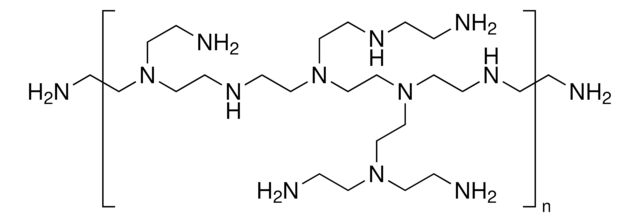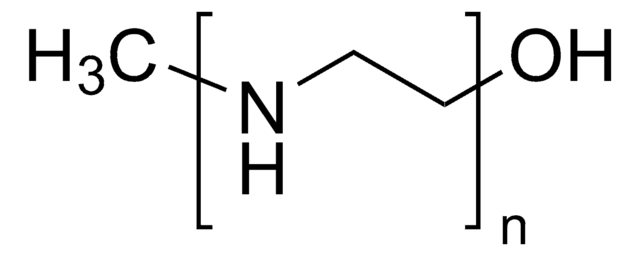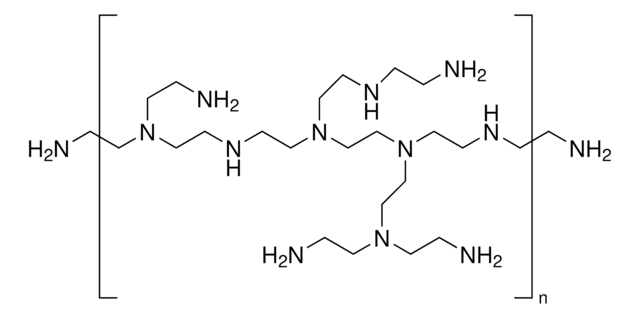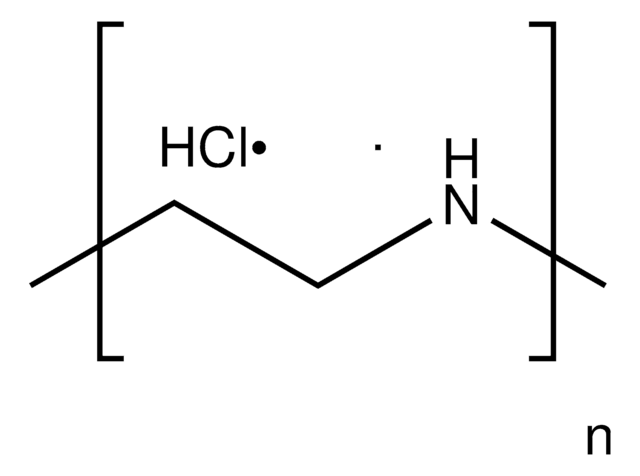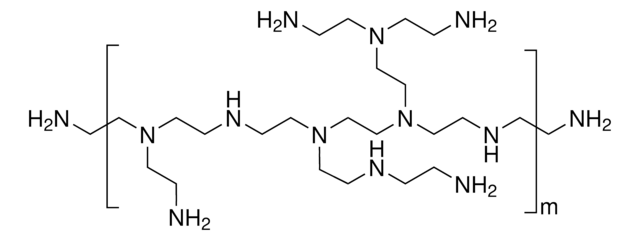推荐产品
形式
viscous liquid
分子量
average Mn ~10,000 by GPC
average Mw ~25,000 by LS
杂质
≤1% water
折射率
n20/D 1.5290
粘度
13,000-18,000(50 °C)
bp
250 °C (lit.)
密度
1.030 g/mL at 25 °C
SMILES字符串
C1CN1
InChI
1S/C2H5N/c1-2-3-1/h3H,1-2H2
InChI key
NOWKCMXCCJGMRR-UHFFFAOYSA-N
正在寻找类似产品? Visit 产品对比指南
一般描述
应用
PEI可用于单壁纳米管 (SWNT) 的功能化修饰,以改善其溶解性和生物相容性,同时维持原始SWNT的结构完整性。共价功能化的SWNT可应用于 CO2 吸收和基因递送。
支链PEI也可用于改变吸附剂的表面性质。PEI修饰的水合氧化锆/PAN纳米纤维可用于地下水的脱氟,因为其具有高氟吸附能力和宽工作pH范围。
特点和优势
支链PEI 具有更好的络合和缓冲能力。
外形
警示用语:
Warning
危险分类
Acute Tox. 4 Oral - Aquatic Chronic 2 - Eye Irrit. 2 - Skin Sens. 1
储存分类代码
10 - Combustible liquids
WGK
WGK 2
个人防护装备
Eyeshields, Faceshields, Gloves, type ABEK (EN14387) respirator filter
分析证书(COA)
输入产品批号来搜索 分析证书(COA) 。批号可以在产品标签上"批“ (Lot或Batch)字后找到。
已有该产品?
为方便起见,与您过往购买产品相关的文件已保存在文档库中。
难以找到您所需的产品或批次号码?
如何查找产品货号
在网站页面上,产品编号会附带包装尺寸/数量一起显示(例如:T1503-25G)。请确保 在“产品编号”字段中仅输入产品编号 (示例: T1503).
示例
其它示例:
705578-5MG-PW
PL860-CGA/SHF-1EA
MMYOMAG-74K-13
1000309185
输入内容 1.000309185)
遇到问题?欢迎随时联系我们技术服务 寻求帮助
如何查找COA批号
批号可以在产品标签上"批“ (Lot或Batch)字后面找到。
Aldrich 产品
如果您查询到的批号为 TO09019TO 等,请输入去除前两位字母的批号:09019TO。
如果您查询到的批号含有填充代码(例如05427ES-021),请输入去除填充代码-021的批号:05427ES。
如果您查询到的批号含有填充代码(例如 STBB0728K9),请输入去除填充代码K9的批号:STBB0728。
未找到您寻找的产品?
部分情况下,可能未在线提供COA。如果搜索不到COA,可在线索取。
Which document(s) contains shelf-life or expiration date information for a given product?
If available for a given product, the recommended re-test date or the expiration date can be found on the Certificate of Analysis.
How do I get lot-specific information or a Certificate of Analysis?
The lot specific COA document can be found by entering the lot number above under the "Documents" section.
What is the concentration and purity of Polyethylenimine, Product 408727?
This product is the pure product of polyethyleneimine. At room temperature this product is a liquid and not a solid. The purity of this product is not routinely determined.
At what temperature does Product 408727, Polyethylenimine, decompose?
Polyethylenimine (mw ~25,000) begins to decompose at 225 °C.
What is the solubility of Product 408727, Polyethylenimine?
We do not test the solubility of this product. However, according to our supplier, this product is miscible with water and ethylene glycol, and soluble in ethanol.
What are the end groups on Product 408727, Polyethylenimine?
The end groups are primary, secondary, and tertiary amines that are in a ratio of 1 : 1.2 : 0.76, respectively.
What is the water content of Product 408727, Polyethylenimine?
This product will contain less than 1% water. The lot specific value is reported on the Certificate of Analysis.
How do I find price and availability?
There are several ways to find pricing and availability for our products. Once you log onto our website, you will find the price and availability displayed on the product detail page. You can contact any of our Customer Sales and Service offices to receive a quote. USA customers: 1-800-325-3010 or view local office numbers.
What is the Department of Transportation shipping information for this product?
Transportation information can be found in Section 14 of the product's (M)SDS.To access the shipping information for this material, use the link on the product detail page for the product.
My question is not addressed here, how can I contact Technical Service for assistance?
Ask a Scientist here.
商品
New methods for materials fabrication at the micro- and nanoscale will drive scientific and technological advances in areas of materials science, chemistry, physics, and biology. The broad diversity of potentially relevant materials, length scales, and architectures underscores the need for flexible patterning approaches. One important example is the fabrication of 3D periodic structures composed of colloidal, polymeric, or semiconductor5 materials.
New methods for materials fabrication at the micro- and nanoscale will drive scientific and technological advances in areas of materials science, chemistry, physics, and biology. The broad diversity of potentially relevant materials, length scales, and architectures underscores the need for flexible patterning approaches. One important example is the fabrication of 3D periodic structures composed of colloidal, polymeric, or semiconductor5 materials.
Gene therapy has become one of the most discussed techniques in biomedical research in recent years.
Professor Yoshiki Katayama (Kyushu University, Japan) discusses recent advances in drug delivery systems and strategies that exploit the EPR effect, with a special focus on stimuli-responsive systems based on novel materials.
我们的科学家团队拥有各种研究领域经验,包括生命科学、材料科学、化学合成、色谱、分析及许多其他领域.
联系技术服务部门